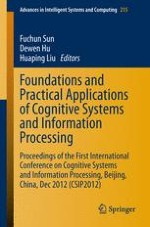"Foundations and Practical Applications of Cognitive Systems and Information Processing" presents selected papers from the First International Conference on Cognitive Systems and Information Processing, held in Beijing, China on December 15-17, 2012 (CSIP2012). The aim of this conference is to bring together experts from different fields of expertise to discuss the state-of-the-art in artificial cognitive systems and advanced information processing, and to present new findings and perspectives on future development. This book introduces multidisciplinary perspectives on the subject areas of Cognitive Systems and Information Processing, including cognitive sciences and technology, autonomous vehicles, cognitive psychology, cognitive metrics, information fusion, image/video understanding, brain-computer interfaces, visual cognitive processing, neural computation, bioinformatics, etc.
The book will be beneficial for both researchers and practitioners in the fields of Cognitive Science, Computer Science and Cognitive Engineering.
Fuchun Sun and Huaping Liu are both professors at the Department of Computer Science & Technology, Tsinghua University, China. Dr. Dewen Hu is a professor at the College of Mechatronics and Automation, National University of Defense Technology, Changsha, China.
